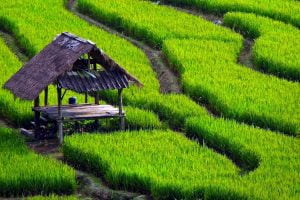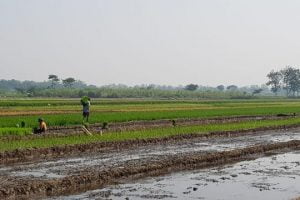
For the Muslims, whatever actions he takes must always refer to the teachings of Islam, which are stated in the Al-Qur’an. For practical matters, the Prophet Muhammad SAW often provided guidance for Muslims, including in land management, especially agricultural land for the sustainability of this land. Therefore, the behavior of a Muslim in any way always glorifies him. The feelings of a Muslim will be deeply hurt if the Prophet Muhammad SAW is insulted, such as by making cartoon films that mock his honor.
Following this, in order to honor the Prophet Muhamad SAW, we present the hadiths that we can take as an example in managing ownership/assets in a country, including the management of agricultural land.
It is reported from Bilal bin Harist Al-Mazini that Rasulullah SAW has given him an entire valley. This hadith was narrated by Abu Ubaid. In another narration it is said that Rasulullah SAW gave Bilal bin Harist Al-Mazini (area) between the sea and the desert.
From Amir ibn Su’aib from his father, that Rasulullah SAW had given land to people who came from Muzainah or Juhainah. The same hadith was also received from Adi bin Hathim. It was also reported from Adi bin Hathim that Rasulullah SAW had given Furat bin Hayyan al-Ajli An area of land in the Yamamah.
From Amru bin Dinar, he told that when Rasulullah SAW lived in Medina, he gave (a piece of land) to Abu Bakr and Umar. Rasulullah SAW also gave Zubair bin Awwam a very large plot of land. And he distributed the land where his horse walked on the dead, watery soil. He also gave the land overgrown with trees and dates. This was narrated by Abu Yusuf and Abu Daud.
Property Ownership
When the Prophet Muhammad SAW distributed these lands, his position was as head of state. In Islamic view, a head of state has the right to give state-owned land to individual citizens who need it. When the head of state sees gaps in agricultural land ownership, or when the head of state sees a group of people who need land for farming activities or for other activities deemed important by the state, the state has the right to give state-owned land to that person.
The assets that exist in a country in the view of Islam are divided into three parts, namely: public property, state property, and individual property. Referring to Hussein Abdillah (2012), assets that enter public ownership include three aspects. First, everything that is a vital need for society, that is, something that is indispensable for community life. If something that is needed is not there, it will cause conflict or anxiety. Society will be scattered looking for these needs. It is like springs (if there are few), grasslands, and fire (energy), according to the Prophet SAW’s words: “People are united in three things, water, pasture, and fire.” Also included in the category of public ownership is any equipment used to manage public facilities, such as water drills needed by the general public and pipes to deliver the water to people’s homes or to public facilities. Likewise the equipment used to generate electricity, poles, cables, and distribution stations.
Second, everything that is naturally impossible for each individual to have and control, such as public roads, rivers, seas, lakes, mosques, public schools, and public squares. This is in accordance with the words of the Prophet Muhammad: “There is no fence except for Allah and His Messenger.” This hadith shows that there is no right for anyone to make a boundary or fence (plotting) something that is intended for the general public.
Third, mining goods with unlimited reserves, namely mining goods which are very large in number. If the quantity is small and limited, the mining goods can become individual property. This means that every individual citizen may own these mining goods. Some examples of mining items with large deposits are: gold, silver, petroleum, phosphate, and so on.
What is argued about the general ownership status of mining goods with large reserves is that Abyadh bin Hamal Al-Mazini has asked Rasulullah SAW for the right to manage a salt mine. Then Rasulullah SAW gave it. After Abyadh left, someone said to Rasulullah SAW, “O Messenger of Allah, do you know what you have given him? Indeed, you have given something like flowing water. “Rasulullah SAW then said: “Withdraw the mining goods from him.” Rasulullah SAW prohibits the control of a salt mine by someone because in fact salt is like running water; the deposit is very large / unlimited, and needed by everyone.
Apart from the aforementioned public ownership, Islam also highly values individual ownership. In other words, Islam recognizes individual property rights. When he moved to Medina, many Medina residents – who are often referred to as Anshor’s shahabah, who were his helpers for the development of da’wah in Medina – had very large agricultural or plantation lands. One of the owners of agricultural land or date palm plantations in Medina is Abu Talha (Zaid bin Sahl) who is famous for his date palm garden called “bairuha.”
It is said that Abu Talha really loved Bairuha’s date palm garden. However, after the passage of verse 92 of Surah Ali-Imran which reads that “You may not arrive at the goodness (which is perfect) before you spend part of the wealth you love,” Abu Tholhah gave the treasure he loved most. He gave his personal property to Rasulullah SAW, and the Prophet accepted it happily. However, in the end the Prophet handed back the property to Abu Tholhah as the owner, while the Prophet advised Abu Tholhah to donate his property to his relatives and closest relatives.
State Owned Land
The land given by the Prophet to a number of individuals as described above was state property. Referring to Husein Abdullah (2012) and A’jaj Al-Karni (2012), as well as various other sources, there is a fundamental difference between public ownership and state ownership, although both are managed by the state for the benefit of the people. Public property will forever remain public property; The state may not share or give assets which enter public ownership to individual citizens. This is different from state property, where the head of state has the right to distribute state assets to a number of individual citizens to achieve equal distribution of asset ownership necessary for the lives of citizens.
Complaining with these sources, which includes state-owned land in the view of Islam, is: desert, mountains, beaches and inanimate land that has no owner; and swamps, namely land covered with water such as the land between Kuffah and Basrah in the era of Umar bin Khathab. Reportedly, these lands were covered by water from the Euphrates and Tigris rivers, after part of the river embankments were damaged, so that the area was inundated and no longer suitable for agriculture. Whereas previously, these lands were garden areas, residences and agricultural land. These puddles began to appear during the time of Kubab bin Fairuz, then multiplied and expanded because Kubab neglected to take care of these lands due to the busy warfare between the Muslims and the Persians. Reportedly, the area of the abandoned land reached 30 farsakh X 30 farsakh or an area of 27,225 km2 because each farsakh is 5.5 km. Due to inundation, the land became unsuitable for agriculture.
In the Islamic view, this kind of land is classified as dead land, although previously on the land there were buildings or agricultural land. As a result, any dead land that has no owner – even if it was once productive land – is categorized as state-owned land. ***
Referrence
Hafidz Ahmad ‘Ajjaj Al-Karmi, 2006, al-Idarah fi Ashri ar-Rasuli SAW, Dar as-Salam, Indonesoan edition, Bogor: Pustaka Thoriqul Izzah
Muhammad Husein Abdillah (1990), ad-Dirosah fi al Fikry al Islamy, Beirut: Dar al Bayariq;



